Here's a list of my favorite Google services that were launched or were significantly improved in 2009.
10. Google Public DNS - a DNS resolution system that doesn't offer too many features, but it's free and fast. Very fast.
9. Google Fast Flip - a service that lets you quickly browse news. It's easy to use and it's a better way to discover interesting news articles than Google News.
8. Google Squared - an innovative way to dynamically generate collections and facts about each item. It's an extension of Google Sets and you can use it to create lists.
7. Google Wave - an online platform for collaboration in real-time. While there are many interesting features in Google Wave, Google's implementation of the Wave protocol is too confusing and difficult to use.
6. Google Translate added new languages, made it easier to find web pages written in other languages and to translate web pages in real-time. You can now use Google Translate in Gmail, Google Docs, Google Groups and many other Google services.
5. Google Maps aggregated information about locations in place pages, started to show more search results and to use its own mapping data in the US. Google also launched Google Maps Navigation, "internet-connected GPS navigation system with voice guidance. It is part of Google Maps for mobile and is available for phones with Android 1.6 and higher." Unlike other navigation apps, Google's Android app is free, but it's limited to the US.
4. Google Image Search added many advanced search options: color filter, size filter, Creative Commons search and an option that lets you find similar images. There's also a great Android app that helps you search the web visually: Google Goggles.
3. Google Search added a toolbelt with many options that help you refine search results: you can restrict the results to forums and recent web pages, find pages shared by your friends, view page thumbnails and explore related searches. Other changes include a redesigned homepage with bigger buttons and less links, Google Suggest as a standard feature and more sitelinks.
2. Android, Google's mobile operating system, had 3 major releases and it's now used by more than 20 devices. Companies like HTC, Motorola, Samsung bet on Android and there are many cool applications that are only available for Android: Goggles, Sky Map, Google Navigation.
1. Google Chrome, the most innovative Google software released last year, continues to be a trendsetter when it comes to simplicity and great performance. It now supports themes and extensions, it has a bookmark sync engine and you can download native versions for Linux and Mac. Chrome is the most significant component of Chrome OS, a browser-centric operating system for notebooks, and a strategic project that helps Google push the web forward. Even if that means improving Internet Explorer.
December 30, 2009
Predictions for Google's 2010
1. Google Chrome's bookmark sync will be extended to sync the documents stored in Google Docs.
2. Google will launch a service that indexes and ranks web applications.
3. Google will use different interfaces for displaying search results, depending on your query.
4. Google's search engine will group related results.
5. Google Image Search will let you upload an image and will show related images from the web.
6. Google Street View's images will become searchable and Google will start to show information about different places in Street View.
7. Google will release an online development environment optimized for building web applications.
8. An open platform for search experiments: tweak Google's ranking factors, customize the interface and create a better search engine.
9. Android will have more users than Windows Mobile.
10. Many browsers will copy Google Chrome's features: the simplified interface, the rapid development model, the lightweight extensions, sandboxing, compiling JavaScript code.
11. Google Drive will finally launch, but it will only be an extended version of Google Docs. Instead of sending attachments, you'll be able to upload files to Google Drive from Gmail.
12. Google Wave won't become successful, but its features will be used in other Google products.
13. Google will buy True Knowledge and will launch a fact search engine.
14. Gmail's spam filtering algorithms will be more transparent and you'll be able to define custom rules for flagging messages as spam.
15. Google Trends will show popular web sites from different categories.
16. Google Desktop will be discontinued and replaced by Google Quick Search Box.
17. If you use Google Chrome, you'll be able to use the most important features of Chrome OS.
18. Google users will be able to add comments and start conversations if they want to find some information about a hot topic.
19. Google Toolbar will be available for Chrome and Google will start to bundle Chrome with Google Toolbar for IE.
20. Google will buy Spotify and make it available for free.
2. Google will launch a service that indexes and ranks web applications.
3. Google will use different interfaces for displaying search results, depending on your query.
4. Google's search engine will group related results.
5. Google Image Search will let you upload an image and will show related images from the web.
6. Google Street View's images will become searchable and Google will start to show information about different places in Street View.
7. Google will release an online development environment optimized for building web applications.
8. An open platform for search experiments: tweak Google's ranking factors, customize the interface and create a better search engine.
9. Android will have more users than Windows Mobile.
10. Many browsers will copy Google Chrome's features: the simplified interface, the rapid development model, the lightweight extensions, sandboxing, compiling JavaScript code.
11. Google Drive will finally launch, but it will only be an extended version of Google Docs. Instead of sending attachments, you'll be able to upload files to Google Drive from Gmail.
12. Google Wave won't become successful, but its features will be used in other Google products.
13. Google will buy True Knowledge and will launch a fact search engine.
14. Gmail's spam filtering algorithms will be more transparent and you'll be able to define custom rules for flagging messages as spam.
15. Google Trends will show popular web sites from different categories.
16. Google Desktop will be discontinued and replaced by Google Quick Search Box.
17. If you use Google Chrome, you'll be able to use the most important features of Chrome OS.
18. Google users will be able to add comments and start conversations if they want to find some information about a hot topic.
19. Google Toolbar will be available for Chrome and Google will start to bundle Chrome with Google Toolbar for IE.
20. Google will buy Spotify and make it available for free.
Last Year's Predictions for 2009
Last year I tried to anticipate some Google-related events from 2009. Let's see if I was right.
1. 10% market share for Google Chrome.
No, Google Chrome's market share is about 4% (3.93% in November, according to Net Applications).
2. Google's search engine will lose a significant amount of market share as Live Search's position will consolidate.
Live Search's relaunch was successful, but Microsoft didn't manage to convince too many users to switch from Google to Bing. Google and Bing increased their market share in 2009, while Yahoo and Ask have a declining market share.
3. Google's Q&A service, used to implement Google help forums, will become a part of Google Apps.
No, not this year.
4. GrandCentral will be publicly available in the US and the interface will integrate with Gmail.
It's not publicly available, but more people can use it. According to a Google report, there are more than 1.4 million users in the US.
5. Google will launch a mobile browser for feature phones and non-Android smart phones.
Google decided to focus on Android.
6. The popular Google Bookmarks service will improve the way you manage bookmarks, by adding hierarchical labels, sharing options and more intuitive visualizations.
Google continues to ignore its bookmarking service.
7. Google will bring some of the Chrome features to other browsers.
Google Toolbar added the "new tab page" and Google Chrome Frame lets you open web pages using Chrome inside Internet Explorer.
8. Google Translate will be seamlessly integrated with many Google services and applications.
A lot of Google services integrate with Google Translate: Google Docs, Google Groups, Gmail, Google Toolbar and more.
9. Google Reader will list popular posts shared by the community and you'll be able to subscribe to OPML files dynamically (the changes will reflect in your subscription list).
There's a "popular items" section in Google Reader, a "what's popular" gadget for iGoogle and you can subscribe to feed bundles, but they're not dynamic.
10. Google Maps Live - Google's service will showcase webcams that stream from all around the world, it will include a tab for Google Earth and the most recent custom maps, reviews and map edits from your contacts.
Google Maps added a layer for webcams and the new social search feature lets you find interesting reviews written by your friends.
11. Google Contacts will become a separate application, it will offer advanced search and an option to synchronize contacts data.
Google Contacts is now available at http://www.google.com/contacts, the search feature has been improved, but it's still difficult to synchronize contacts.
12. Google's efforts to promote Chrome will change people's perception about Google, which will be increasingly associated with Microsoft.
Not everybody is happy to see Google promoting its browser on the homepage, in YouTube and across the web.
13. Many high-profile Google employees, including Marissa Mayer, will leave the company.
Marissa Mayer didn't leave Google, but a lot of top executives left Google this year.
14. Google Apps will start to be attractive again once the App Engine will be fully released.
Google Apps had a great year, but it wasn't because of the App Engine. "Companies around the world are moving to the cloud with Google Apps, and we just crossed the two million customers milestone," mentioned Google's blog in November. Google managed to double the number of customers that use Google Apps.
15. Personalized search ads for users that are logged in.
Google started to personalize content ads and to show ads that are related to your previous Google searches.
16. OneGoogle - a new interface that merges all Google applications so you can quickly switch between Gmail, Google Calendar, Google Docs without opening a new tab or losing your work.
No, there's no unified interface for the desktop.
1. 10% market share for Google Chrome.
No, Google Chrome's market share is about 4% (3.93% in November, according to Net Applications).
2. Google's search engine will lose a significant amount of market share as Live Search's position will consolidate.
Live Search's relaunch was successful, but Microsoft didn't manage to convince too many users to switch from Google to Bing. Google and Bing increased their market share in 2009, while Yahoo and Ask have a declining market share.
3. Google's Q&A service, used to implement Google help forums, will become a part of Google Apps.
No, not this year.
4. GrandCentral will be publicly available in the US and the interface will integrate with Gmail.
It's not publicly available, but more people can use it. According to a Google report, there are more than 1.4 million users in the US.
5. Google will launch a mobile browser for feature phones and non-Android smart phones.
Google decided to focus on Android.
6. The popular Google Bookmarks service will improve the way you manage bookmarks, by adding hierarchical labels, sharing options and more intuitive visualizations.
Google continues to ignore its bookmarking service.
7. Google will bring some of the Chrome features to other browsers.
Google Toolbar added the "new tab page" and Google Chrome Frame lets you open web pages using Chrome inside Internet Explorer.
8. Google Translate will be seamlessly integrated with many Google services and applications.
A lot of Google services integrate with Google Translate: Google Docs, Google Groups, Gmail, Google Toolbar and more.
9. Google Reader will list popular posts shared by the community and you'll be able to subscribe to OPML files dynamically (the changes will reflect in your subscription list).
There's a "popular items" section in Google Reader, a "what's popular" gadget for iGoogle and you can subscribe to feed bundles, but they're not dynamic.
10. Google Maps Live - Google's service will showcase webcams that stream from all around the world, it will include a tab for Google Earth and the most recent custom maps, reviews and map edits from your contacts.
Google Maps added a layer for webcams and the new social search feature lets you find interesting reviews written by your friends.
11. Google Contacts will become a separate application, it will offer advanced search and an option to synchronize contacts data.
Google Contacts is now available at http://www.google.com/contacts, the search feature has been improved, but it's still difficult to synchronize contacts.
12. Google's efforts to promote Chrome will change people's perception about Google, which will be increasingly associated with Microsoft.
Not everybody is happy to see Google promoting its browser on the homepage, in YouTube and across the web.
13. Many high-profile Google employees, including Marissa Mayer, will leave the company.
Marissa Mayer didn't leave Google, but a lot of top executives left Google this year.
14. Google Apps will start to be attractive again once the App Engine will be fully released.
Google Apps had a great year, but it wasn't because of the App Engine. "Companies around the world are moving to the cloud with Google Apps, and we just crossed the two million customers milestone," mentioned Google's blog in November. Google managed to double the number of customers that use Google Apps.
15. Personalized search ads for users that are logged in.
Google started to personalize content ads and to show ads that are related to your previous Google searches.
16. OneGoogle - a new interface that merges all Google applications so you can quickly switch between Gmail, Google Calendar, Google Docs without opening a new tab or losing your work.
No, there's no unified interface for the desktop.
December 23, 2009
Import Your Maps in Google City Tours
Google City Tours, the service that generates walking tours for important cities, has a new feature that lets you import custom maps. After logging to a Google Account, you can go to the importing page and select one of your maps.

The service would more useful if you could customize a tour by reordering sights and defining constraints. Other features that seems to be missing: saving tours, sharing and printing tours.
Google City Tours will probably become a feature of Google Maps that will help you find more about a city and plan your trips.

The service would more useful if you could customize a tour by reordering sights and defining constraints. Other features that seems to be missing: saving tours, sharing and printing tours.
Google City Tours will probably become a feature of Google Maps that will help you find more about a city and plan your trips.
December 21, 2009
Open Google
Jonathan Rosenberg, Senior Vice President at Google, wrote a very interesting email about the value of openness on the web and sent the email to Google's employees. He recommends Googlers to use open standards, to open source software, to make it easy to export data from Google's services and to fight for an open Internet.
It's interesting to notice that many of the products released by Google in the past 2 years are open platforms (Android, Chrome), proposals for open standards (o3d , OpenSocial, Google Wave Protocol) and not just Google services. Google actually invests in a better web.
"If you are trying to grow an entire industry as broadly as possible, open systems trump closed. And that is exactly what we are trying to do with the Internet. Our commitment to open systems is not altruistic. Rather it's good business, since an open Internet creates a steady stream of innovations that attracts users and usage and grows the entire industry," explains Jonathan Rosenberg.
Open systems are (...) competitive and far more dynamic. In an open system, a competitive advantage doesn't derive from locking in customers, but rather from understanding the fast-moving system better than anyone else and using that knowledge to generate better, more innovative products. (...)
We use tens of millions of lines of open source code to run our products. We also give back: we are the largest open source contributor in the world, contributing over 800 projects that total over 20 million lines of code to open source, with four projects (Chrome, Android, Chrome OS, and Google Web Toolkit) of over a million lines of code each. (...)
The ability to switch is critical, so instead of building walls around your product, build bridges. (...)
We believe in the power of technology to deliver information. We believe in the power of information to do good. We believe that open is the only way for this to have the broadest impact for the most people. We are technology optimists who trust that the chaos of open benefits everyone. We will fight to promote it every chance we get. Open will win. It will win on the Internet and will then cascade across many walks of life: The future of government is transparency. The future of commerce is information symmetry. The future of culture is freedom. The future of science and medicine is collaboration. The future of entertainment is participation. Each of these futures depends on an open Internet.
It's interesting to notice that many of the products released by Google in the past 2 years are open platforms (Android, Chrome), proposals for open standards (o3d , OpenSocial, Google Wave Protocol) and not just Google services. Google actually invests in a better web.
"If you are trying to grow an entire industry as broadly as possible, open systems trump closed. And that is exactly what we are trying to do with the Internet. Our commitment to open systems is not altruistic. Rather it's good business, since an open Internet creates a steady stream of innovations that attracts users and usage and grows the entire industry," explains Jonathan Rosenberg.
December 20, 2009
Funny Google Suggestions
When you start to type a query, Google suggests popular search terms that include your keywords. Sometimes the suggestions are surprising, especially when the suggested queries are long and descriptive. A suggestion like [i was bitten by a turtle when i was a young lad should i still drink orange juice] might surprise you if you didn't know that it was a question on Yahoo Answers that became famous.

Other suggestions could be popular songs, movie quotes or Internet memes. For example, [Dinosaurs were made up by the CIA to discourage time travel] is the name of a song.

The two examples are from Autocomplete Me, a site that collects funny Google suggestions and lets you rate them.

Other suggestions could be popular songs, movie quotes or Internet memes. For example, [Dinosaurs were made up by the CIA to discourage time travel] is the name of a song.

The two examples are from Autocomplete Me, a site that collects funny Google suggestions and lets you rate them.
December 18, 2009
Google Chrome Advent Calendar Projection
Google Chrome, the most advertised Google product, is promoted using a calendar projection in London.
"Google Chrome, the big G's web browser and fledgling operating system, is touting itself with a giant advent calendar projected onto the wall of a shopping center in London. The calendar [is] counting down the days until [Christmas] on the side of enormous shopping complex Westfield in Shepherds Bush, West London," wrote Daily Mirror.
In other news, if you want to see how many seconds are left until the New Year, go to Google's homepage and click "I'm Feeling Lucky".
{ via Google Blogoscoped }
"Google Chrome, the big G's web browser and fledgling operating system, is touting itself with a giant advent calendar projected onto the wall of a shopping center in London. The calendar [is] counting down the days until [Christmas] on the side of enormous shopping complex Westfield in Shepherds Bush, West London," wrote Daily Mirror.
In other news, if you want to see how many seconds are left until the New Year, go to Google's homepage and click "I'm Feeling Lucky".
{ via Google Blogoscoped }
On Google's Unofficial Dictionary API
Google Dictionary has an undocumented API that's used in Google Docs. You can obtain a JSON output using a URL like:
http://www.google.com/dictionary/json?callback=dict_api.callbacks.id100&q=test&sl=en&tl=en&restrict=pr%2Cde&client=te
(replace test with your favorite keyword).
A developer built a Chrome extension that used Google Dictionary API to display the definitions of a word without opening a new page.

A few days after releasing the extension, Google asked the developer to stop using the API.
"Until recently, this extension was known as Google Dictionary Lookup and used as its data source the Google Dictionary. Unfortunately, due to Google's contracts with their data providers, they are not legally allowed to expose the Dictionary API to third parties, and as such, I was forced to switch providers. (...) In the spirit of FOSS, I'm leaving the source code of the previous version available at my site until Dec 25, but you are solely responsible for its use, and I urge you not to abuse the Google Dictionary API," explains Max.
If you'd like to see an official API for Google Dictionary, star this issue.
http://www.google.com/dictionary/json?callback=dict_api.callbacks.id100&q=test&sl=en&tl=en&restrict=pr%2Cde&client=te
(replace test with your favorite keyword).
A developer built a Chrome extension that used Google Dictionary API to display the definitions of a word without opening a new page.

A few days after releasing the extension, Google asked the developer to stop using the API.
"Until recently, this extension was known as Google Dictionary Lookup and used as its data source the Google Dictionary. Unfortunately, due to Google's contracts with their data providers, they are not legally allowed to expose the Dictionary API to third parties, and as such, I was forced to switch providers. (...) In the spirit of FOSS, I'm leaving the source code of the previous version available at my site until Dec 25, but you are solely responsible for its use, and I urge you not to abuse the Google Dictionary API," explains Max.
If you'd like to see an official API for Google Dictionary, star this issue.
Google Browser Size
Google Browser Size is an experimental service that shows if a web page has interface elements that can't be viewed by a significant amount of people. "Google Browser Size is a visualization of browser window sizes for people who visit Google. For example, the 90% contour means that 90% of people visiting Google have their browser window open to at least this size or larger."
The service can be used for any web page, but the data is obtained from the visitors of google.com. As you can see from the screenshot, Google's top result can be viewed by more than 99% of the visitors if no ad is displayed above the results.

Google Browser Size is one of the many Google tools that help you optimize web sites:
* Google Website Optimizer - testing and optimization tool
* Google Analytics - web analytics
* Google Webmaster Tools - site performance, crawl errors, top search queries
* Page Speed - an open-source Firebug add-on that helps you evaluate the performance of a web page.
* Speed Tracer - a Chrome extension that helps you fix performance problems in your web applications.
* Closure Compiler - a tool for making JavaScript download and run faster.
* "Let's make the web faster" tutorials.
{ Thanks, Kevin. }
The service can be used for any web page, but the data is obtained from the visitors of google.com. As you can see from the screenshot, Google's top result can be viewed by more than 99% of the visitors if no ad is displayed above the results.

Google Browser Size is one of the many Google tools that help you optimize web sites:
* Google Website Optimizer - testing and optimization tool
* Google Analytics - web analytics
* Google Webmaster Tools - site performance, crawl errors, top search queries
* Page Speed - an open-source Firebug add-on that helps you evaluate the performance of a web page.
* Speed Tracer - a Chrome extension that helps you fix performance problems in your web applications.
* Closure Compiler - a tool for making JavaScript download and run faster.
* "Let's make the web faster" tutorials.
{ Thanks, Kevin. }
December 16, 2009
Clean Up Duplicate Contacts in Gmail
In January, Gmail's Product Manager Todd Jackson said that Gmail will include a contact deduplicator. "Jackson says a de-duper is on the way and that contacts will have more of a presence both in your inbox and in conversations."
11 months later, Gmail added a feature that detects and merges duplicate contacts. "To clean up your contact list in one fell swoop, just click the Find duplicates button in the contact manager, review the merge suggestions (and uncheck any suggestions you don't want merged), and hit the Merge button." If you have many contacts, it's a good idea to consolidate them and to have a single contact for each person.
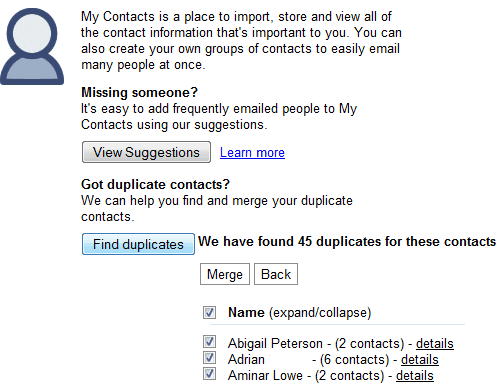
Other popular webmail services included this feature a long time ago: Yahoo Mail and Hotmail added tools for cleaning up duplicate contacts in 2007.
11 months later, Gmail added a feature that detects and merges duplicate contacts. "To clean up your contact list in one fell swoop, just click the Find duplicates button in the contact manager, review the merge suggestions (and uncheck any suggestions you don't want merged), and hit the Merge button." If you have many contacts, it's a good idea to consolidate them and to have a single contact for each person.

Other popular webmail services included this feature a long time ago: Yahoo Mail and Hotmail added tools for cleaning up duplicate contacts in 2007.
December 15, 2009
Google Smart Suggest
Google has recently added a feature that makes search suggestions even more useful. Let's say you type [christmas shop] and then you realize that you wanted to search for [christmas tree shop]. You don't have to add the word "tree" to your query: just type "t" before "shop" and Google adjusts the suggestions. The first suggested query is [christmas tree shop].
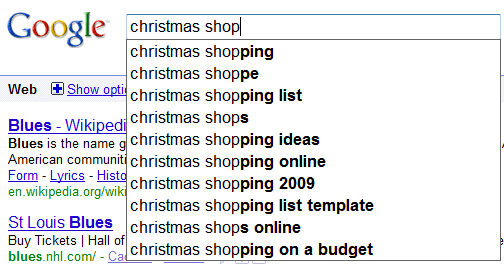
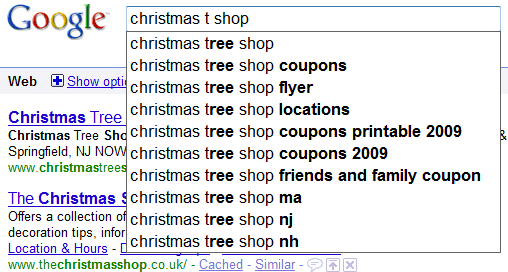
The change may seem subtle, but I think it's really significant: Google takes into account the caret position and shows suggestions for the word you are currently typing.
Here's another way to use smart suggestions: type "cat" in the search box, then type "r" before "cat". The first suggestion is [ragdoll cat], a popular query starts with "r" and includes the word "cat".
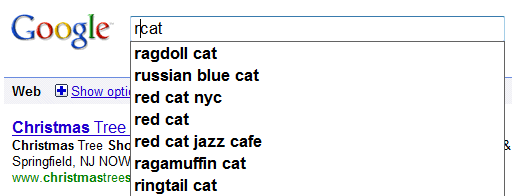
Yet another reason to use Google's search box instead of typing a query in your browser's search box.


The change may seem subtle, but I think it's really significant: Google takes into account the caret position and shows suggestions for the word you are currently typing.
Here's another way to use smart suggestions: type "cat" in the search box, then type "r" before "cat". The first suggestion is [ragdoll cat], a popular query starts with "r" and includes the word "cat".

Yet another reason to use Google's search box instead of typing a query in your browser's search box.
Google Real-Time Irrelevance
Google decided to show real-time search results for some popular queries, but the implementation failed miserably. Google forgot to focus on relevancy and started to show irrelevant results from Twitter. Just because someone posts uninteresting messages about a popular topic doesn't mean that the tweets are suddenly relevant.




An article from Wired quoted Google's Amit Singhal, who explained that "Google Real Time search is Google's relevance technology meeting the real-time web":
From what I've seen so far, Google's real-time search shows the limitations of Google's relevance technology. Until these limitations are addressed, Google should stop cluttering the search results with irrelevant Twitter messages.




An article from Wired quoted Google's Amit Singhal, who explained that "Google Real Time search is Google's relevance technology meeting the real-time web":
Google said its real-time search offers not just a stream of data, but an organized stream filtered of spam and other irrelevant information. The key to keeping the updates relevant is that Google judges "author quality," "probability of relevance" and "query hotness," according to Singhal. "That's what real-time search is all about," he said.
From what I've seen so far, Google's real-time search shows the limitations of Google's relevance technology. Until these limitations are addressed, Google should stop cluttering the search results with irrelevant Twitter messages.
Google Docs Indexes PDF Files
This feature should've been added a long time ago: Google Docs indexes PDF files and you can finally search the contents of all your files.
Google Docs search has been recently improved by adding support for automatic stemming and synonyms, so you can search for [create shortcut] and find documents that contain [creating shortcuts] or [creates a shortcut].
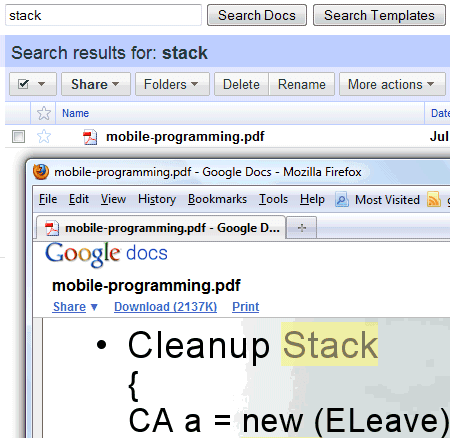
To make things even better, Google should detect scanned PDF documents and use OCR to extract text. This feature is already used by Google's search engine to index scanned documents and it's available as an experiment for Google Docs API.
Google Docs search has been recently improved by adding support for automatic stemming and synonyms, so you can search for [create shortcut] and find documents that contain [creating shortcuts] or [creates a shortcut].

To make things even better, Google should detect scanned PDF documents and use OCR to extract text. This feature is already used by Google's search engine to index scanned documents and it's available as an experiment for Google Docs API.
December 14, 2009
FeedBurner Socialize: Add Your Feed to Twitter
If you've used TwitterFeed to post updates from a blog to your Twitter account, you'll like FeedBurner Socialize. It's a new FeedBurner feature that distributes the content from a feed on Twitter.
"To get started, go to the Socialize service on FeedBurner's Publicize tab and add the Twitter account to which you would like to post items from your feed. You can take the default settings and click [Save] to start socializing immediately, or use the options we offer to customize exactly which feed items are sent to Twitter and how exactly you would like them to look. The next time you post a new item to your feed it will be sent to Twitter," mentions FeedBurner's blog.
Socialize uses Google's new URL shortener and it adds a parameter that helps you track Twitter traffic in Google Analytics.

My favorite thing about FeedBurner Socialize is that the tweet is posted immediately after I publish a blog post. That's because both FeedBurner and Blogger support PubSubHubbub, a protocol designed for near-instant notifications.

"To get started, go to the Socialize service on FeedBurner's Publicize tab and add the Twitter account to which you would like to post items from your feed. You can take the default settings and click [Save] to start socializing immediately, or use the options we offer to customize exactly which feed items are sent to Twitter and how exactly you would like them to look. The next time you post a new item to your feed it will be sent to Twitter," mentions FeedBurner's blog.
Socialize uses Google's new URL shortener and it adds a parameter that helps you track Twitter traffic in Google Analytics.

My favorite thing about FeedBurner Socialize is that the tweet is posted immediately after I publish a blog post. That's because both FeedBurner and Blogger support PubSubHubbub, a protocol designed for near-instant notifications.

Share Web Pages and Your Location in Google Toolbar
Google Toolbar 6.4 for IE and Firefox adds a feature that lets you share web pages using social networking sites, mail services, bookmarking services and other sites. You can select your favorite services from the settings page or repeatedly click on one of the options to bring it to the top of the menu.

If you share links using Twitter, you'll notice a new URL shortening service: goo.gl. "Google URL Shortener at goo.gl is a service that takes long URLs and squeezes them into fewer characters to make a link that is easier to share, tweet, or email to friends. The core goals of this service are: stability, security and speed." The service is only used by Google Toolbar and FeedBurner, so there's no web interface or API for goo.gl.
Another new Google Toolbar feature implements W3C's geolocation API, which allows web pages to access detailed information about the locations of their visitors. "We use information transmitted by nearby WiFi access points to determine your approximate location. Accuracy and coverage will vary by location, and we're working to improve both over time," explains Google. This feature is already available in Firefox 3.5, so Google only added it to the IE version of Google Toolbar.

One of the few sites that use the geolocation API is Google Maps: "visit Google Maps and click the My Location button above the zoom slider. Click Share my location if you give your permission for Google Maps to use your location, and the map should center on your approximate location, if available."
{ via Google Blog }

If you share links using Twitter, you'll notice a new URL shortening service: goo.gl. "Google URL Shortener at goo.gl is a service that takes long URLs and squeezes them into fewer characters to make a link that is easier to share, tweet, or email to friends. The core goals of this service are: stability, security and speed." The service is only used by Google Toolbar and FeedBurner, so there's no web interface or API for goo.gl.
Another new Google Toolbar feature implements W3C's geolocation API, which allows web pages to access detailed information about the locations of their visitors. "We use information transmitted by nearby WiFi access points to determine your approximate location. Accuracy and coverage will vary by location, and we're working to improve both over time," explains Google. This feature is already available in Firefox 3.5, so Google only added it to the IE version of Google Toolbar.

One of the few sites that use the geolocation API is Google Maps: "visit Google Maps and click the My Location button above the zoom slider. Click Share my location if you give your permission for Google Maps to use your location, and the map should center on your approximate location, if available."
{ via Google Blog }
December 12, 2009
Google Video Finds Cartoons and Slideshows
Google Video has a new feature that lets you restrict search results to cartoons and slideshows. After performing a search, click "Show options" and select "Cartoons" or "Slideshows" from the list of options. Google uses a video recognition technology that tries to classify videos, but the accuracy is far from impressive.

Unfortunately, Google's video search engine ruined the "TV view" feature that allowed you to play videos without opening a new page. YouTube videos are no longer played in the embedded player, while the other videos are played on the search results page only if you click on "Play video".

Unfortunately, Google's video search engine ruined the "TV view" feature that allowed you to play videos without opening a new page. YouTube videos are no longer played in the embedded player, while the other videos are played on the search results page only if you click on "Play video".
December 11, 2009
Instant Answers in Google Suggest
Google's search suggestions started to include instant answers for Math calculations, unit conversions, currency conversions, weather information, simple facts, local time, package tracking, word definitions and more. That means you no longer have to click the search button and open a new page to see the results: the answers are displayed instantly.
"This kind of information will appear in Suggest either above or below the suggested search terms for a variety of queries. For example, you can type "delta 140" to see the flight status. You can also quickly discover the current time, figure out how many Euros you'll get per dollar, or even brush up on metric conversions," explains Google.
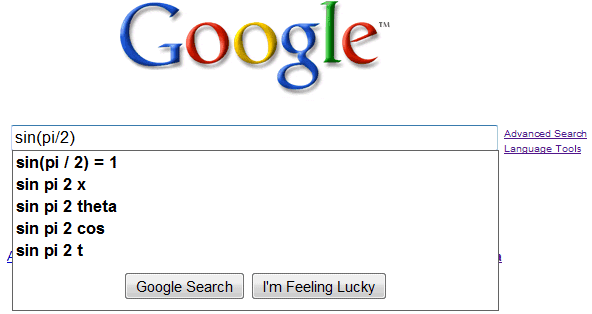



My only issue is that Google's answers can't be copied. If you try to select the suggestion, you'll notice that the answer is not added to the search box, so the only way to copy the result is to open the search results page.
Some of the instant answers are available even if you don't use Google's homepage: check the search suggestions from Firefox, Chrome, IE 8 and Google Toolbar.

"This kind of information will appear in Suggest either above or below the suggested search terms for a variety of queries. For example, you can type "delta 140" to see the flight status. You can also quickly discover the current time, figure out how many Euros you'll get per dollar, or even brush up on metric conversions," explains Google.




My only issue is that Google's answers can't be copied. If you try to select the suggestion, you'll notice that the answer is not added to the search box, so the only way to copy the result is to open the search results page.
Some of the instant answers are available even if you don't use Google's homepage: check the search suggestions from Firefox, Chrome, IE 8 and Google Toolbar.

December 9, 2009
Google Quick Scroll
Google Quick Scroll is a Google Chrome extension that helps you find the best matches for your query when you click on a Google search result.
"Quick Scroll may appear on the bottom-right corner of the page, showing one or more bits of text from the page that are relevant to your query. Clicking on the text will take you to that part of the page. Quick Scroll appears only when it is likely to be useful."
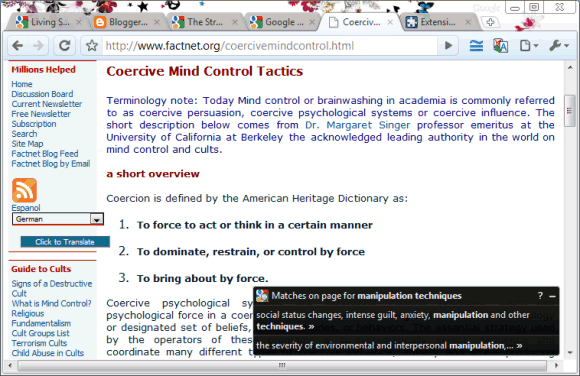
The extension uses the snippet generated for a search result and tries to locate each excerpt, but this approach isn't always successful because some snippets are obtained from meta tags or from the Open Directory Project.
Google Quick Scroll is one of the many Chrome extensions created by Google. To install them, you need Google Chrome 4 Beta (Windows, Linux).
"Quick Scroll may appear on the bottom-right corner of the page, showing one or more bits of text from the page that are relevant to your query. Clicking on the text will take you to that part of the page. Quick Scroll appears only when it is likely to be useful."

The extension uses the snippet generated for a search result and tries to locate each excerpt, but this approach isn't always successful because some snippets are obtained from meta tags or from the Open Directory Project.
Google Quick Scroll is one of the many Chrome extensions created by Google. To install them, you need Google Chrome 4 Beta (Windows, Linux).
Living Stories, a New Way to Read News
Google Labs launched an interesting service in partnership with New York Times and Washington Post: Living Stories. The goal is to change the way you interact with news online and to read news stories as they unfold.
"Each living story resides at a permanent URL, making it easier to follow the latest updates to the stories that interest you, as well as review deeper background materials that are relevant for a story's context. Living Stories automatically track your interaction with the story, making sure that you are always presented with the news you need, the way you want it. You can read full articles and browse multimedia without ever leaving the Living Story page. Just expand the content you want to see, and minimize it when you're done. Whether you want a short update, deep analysis, feature stories, video, or important quotes, everything related to the story is on the Living Story page."


Google Living Stories aggregates a lot of useful information, but some people might find it overwhelming.
"Each living story resides at a permanent URL, making it easier to follow the latest updates to the stories that interest you, as well as review deeper background materials that are relevant for a story's context. Living Stories automatically track your interaction with the story, making sure that you are always presented with the news you need, the way you want it. You can read full articles and browse multimedia without ever leaving the Living Story page. Just expand the content you want to see, and minimize it when you're done. Whether you want a short update, deep analysis, feature stories, video, or important quotes, everything related to the story is on the Living Story page."


Google Living Stories aggregates a lot of useful information, but some people might find it overwhelming.
Export All Your Google Documents in 3 Steps
Google made it easier to export all your documents, spreadsheets, presentations and PDFs from Google Docs:
1. right-click on one of the files from the docs list and select "Export"
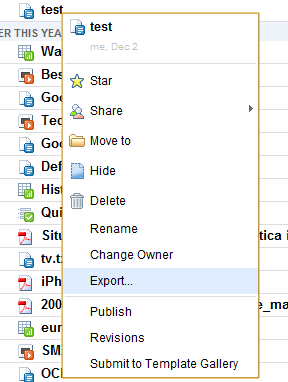
2. check "export all your files (up to 2 GB)" and click on "Continue"
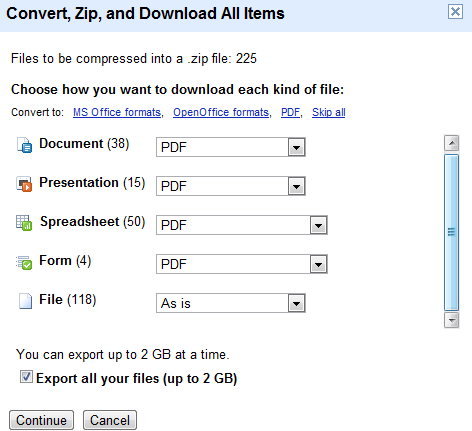
3. wait until the files are archived or click on "Email when ready"
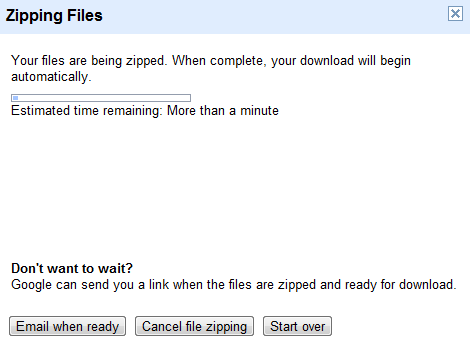
While this is a great way to backup all your files, an application that synchronizes your documents would be more useful.
{ via Google Docs Blog }
1. right-click on one of the files from the docs list and select "Export"

2. check "export all your files (up to 2 GB)" and click on "Continue"

3. wait until the files are archived or click on "Email when ready"

While this is a great way to backup all your files, an application that synchronizes your documents would be more useful.
{ via Google Docs Blog }
Google Docs Sorts Results by Relevance
Google Docs started to sort search results by relevance. Until now, search results were sorted by the last modified date.
"This improvement to search within Docs also includes automatic stemming and synonyms. So if you search for check account, we'll also include results for a few variations of those words, including checking account (which is what you probably meant to type). Or if you search for mac book, we'll also include results for macbook."
The results are not perfect, but at least the documents that include your keywords in the title are prioritized. It would be useful to display a snippet for each search result and an option to preview a document before opening it.
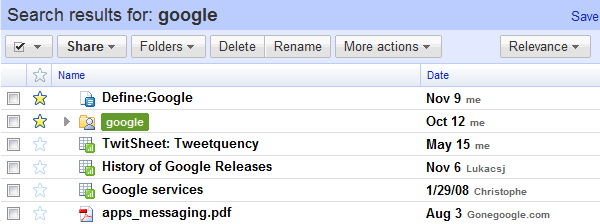
If you'd like to sort the results by date, click on "Relevance" and select "Last modified" from the drop-down.
"This improvement to search within Docs also includes automatic stemming and synonyms. So if you search for check account, we'll also include results for a few variations of those words, including checking account (which is what you probably meant to type). Or if you search for mac book, we'll also include results for macbook."
The results are not perfect, but at least the documents that include your keywords in the title are prioritized. It would be useful to display a snippet for each search result and an option to preview a document before opening it.

If you'd like to sort the results by date, click on "Relevance" and select "Last modified" from the drop-down.
December 8, 2009
Google Chrome Extensions Gallery, Chrome Beta for Mac and Linux
Google launched an extensions gallery for Google Chrome and added support for extensions in Chrome 4 Beta (Windows and Linux only). Google also released the first beta version of Chrome for Mac, but it doesn't have support for extensions.
The extensions gallery includes 371 extensions. You shouldn't expect to find complex extensions, toolbars, download managers: Chrome extensions are lightweight, they have a minimalistic interface and few of them are customizable. There's a Gmail extension that displays the number of unread messages from your inbox, an extension that lets you subscribe to feeds, a Google Reader notifier, a Google News button, an ad-blocker, a Google Tasks button, extensions for StumbleUpon, Picnik, eBay, WOT, Twitter and Facebook.
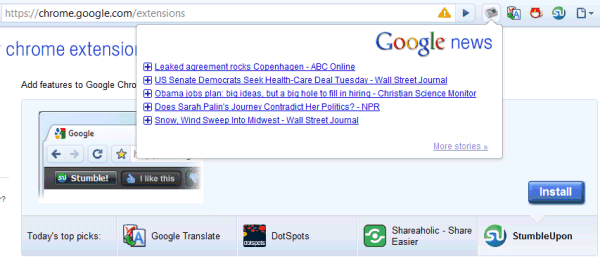
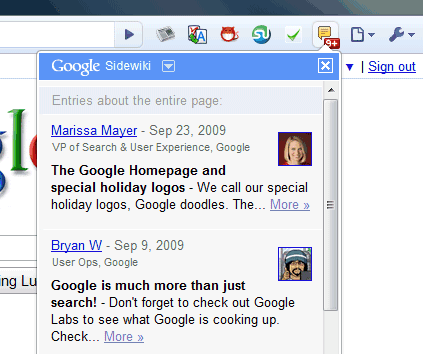
Most extensions add small icons next to the address bar so you can perform certain actions by clicking on the icon. They're similar to Google Toolbar's buttons, but Google Chrome's extensions can also modify web pages. The browser has built-in support for Greasemonkey scripts and many extensions are obtained from bookmarklets and user scripts.
"We wanted to make extensions easy to create and maintain, while preserving Google Chrome's speed and stability. Extensions on Google Chrome accomplishes all these goals: they are as easy to create as web pages, easy to install, and each extension runs in its own process to avoid crashing or significantly slowing down the browser," explains Google. In Google Chrome, you don't have to restart the browser to install an extension or to disable an extension.
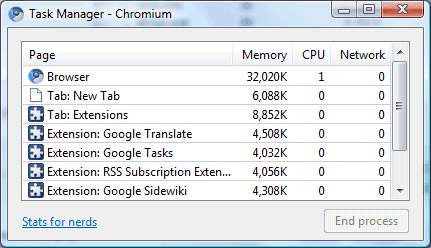
The first beta version of Google Chrome for Mac doesn't include all the features that are available in the Windows version, at least not yet. "In bringing the Mac version of Google Chrome from its developer stages to a beta standard, we returned to the core principles of the Chromium project and focused on delivering rock-solid depth in a few critical areas for the browser, rather than a breadth of features that are rough around the edges. This first beta release for Mac does not yet incorporate extensions, bookmark sync, bookmark manager, and cookie manager," mentions Google.
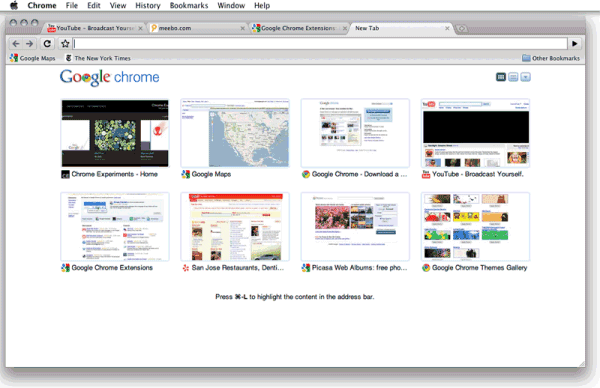
The Linux version is more mature and it includes support for extensions. "At Google, most engineers use Linux machines, so we certainly heard loud and clear how much they wanted Google Chrome for Linux. Just like Google Chrome for Windows and Mac, we focused on speed, stability and security, but we also wanted a high-performance browser that integrated well with the Linux ecosystem. This includes tight integration with native GTK themes, updates that are managed by the standard system package manager, and many other features that fit in natively with the operating system where possible."
Useful links:
Chrome 4 Beta: Windows, Linux, Mac
Chrome extensions gallery
How to develop Chrome extensions
The extensions gallery includes 371 extensions. You shouldn't expect to find complex extensions, toolbars, download managers: Chrome extensions are lightweight, they have a minimalistic interface and few of them are customizable. There's a Gmail extension that displays the number of unread messages from your inbox, an extension that lets you subscribe to feeds, a Google Reader notifier, a Google News button, an ad-blocker, a Google Tasks button, extensions for StumbleUpon, Picnik, eBay, WOT, Twitter and Facebook.


Most extensions add small icons next to the address bar so you can perform certain actions by clicking on the icon. They're similar to Google Toolbar's buttons, but Google Chrome's extensions can also modify web pages. The browser has built-in support for Greasemonkey scripts and many extensions are obtained from bookmarklets and user scripts.
"We wanted to make extensions easy to create and maintain, while preserving Google Chrome's speed and stability. Extensions on Google Chrome accomplishes all these goals: they are as easy to create as web pages, easy to install, and each extension runs in its own process to avoid crashing or significantly slowing down the browser," explains Google. In Google Chrome, you don't have to restart the browser to install an extension or to disable an extension.

The first beta version of Google Chrome for Mac doesn't include all the features that are available in the Windows version, at least not yet. "In bringing the Mac version of Google Chrome from its developer stages to a beta standard, we returned to the core principles of the Chromium project and focused on delivering rock-solid depth in a few critical areas for the browser, rather than a breadth of features that are rough around the edges. This first beta release for Mac does not yet incorporate extensions, bookmark sync, bookmark manager, and cookie manager," mentions Google.

The Linux version is more mature and it includes support for extensions. "At Google, most engineers use Linux machines, so we certainly heard loud and clear how much they wanted Google Chrome for Linux. Just like Google Chrome for Windows and Mac, we focused on speed, stability and security, but we also wanted a high-performance browser that integrated well with the Linux ecosystem. This includes tight integration with native GTK themes, updates that are managed by the standard system package manager, and many other features that fit in natively with the operating system where possible."
Useful links:
Chrome 4 Beta: Windows, Linux, Mac
Chrome extensions gallery
How to develop Chrome extensions
December 7, 2009
Google Real-Time Search
Google launched a real-time search service that that aggregates recent news articles, blog posts and messages from Twitter, FriendFeed, Jaiku, Identi.ca, MySpace and Facebook.
Google tries to find the keywords that are suddenly popular in recent news articles, blog posts, Twitter messages. The most popular 10 keywords are available at Google Trends and they trigger a real-time search OneBox.
"When they are relevant, we'll rank these latest results to show the freshest information right on the search results page. Try searching for your favorite TV show, sporting event or the latest development on a recent government bill. Whether it's an eyewitness tweet, a breaking news story or a fresh blog post, you can find it on Google right after it's published on the web," explains Google.

Here's an example of real-time search results page for [Google]:
Surprisingly, Google sorts the results by date, so you won't be able to use the service to find popular tweets, news articles that are frequently referenced, you'll still find spam messages and re-tweets. There are plenty of search engines that aggregate messages from micro-blogging services (Twingly, FriendFeed), but none of them managed to rank the results by relevance.
In May, Marissa Mayer discussed the significance of Twitter for Google:
"What's really happening in Twitter is that there are a lot of clues in it in terms of what's happening that's interesting overall. It's similar to what we see in Google Trends, where people will often type what they're interested in into the search box, and we can make some predictions off of that. So we are interested in being able to offer, for example, micro-blogging and micro-messaging in our search. Particularly in Blog Search and possibly in Web Search."
Google tries to find the keywords that are suddenly popular in recent news articles, blog posts, Twitter messages. The most popular 10 keywords are available at Google Trends and they trigger a real-time search OneBox.
"When they are relevant, we'll rank these latest results to show the freshest information right on the search results page. Try searching for your favorite TV show, sporting event or the latest development on a recent government bill. Whether it's an eyewitness tweet, a breaking news story or a fresh blog post, you can find it on Google right after it's published on the web," explains Google.

Here's an example of real-time search results page for [Google]:
Surprisingly, Google sorts the results by date, so you won't be able to use the service to find popular tweets, news articles that are frequently referenced, you'll still find spam messages and re-tweets. There are plenty of search engines that aggregate messages from micro-blogging services (Twingly, FriendFeed), but none of them managed to rank the results by relevance.
In May, Marissa Mayer discussed the significance of Twitter for Google:
"What's really happening in Twitter is that there are a lot of clues in it in terms of what's happening that's interesting overall. It's similar to what we see in Google Trends, where people will often type what they're interested in into the search box, and we can make some predictions off of that. So we are interested in being able to offer, for example, micro-blogging and micro-messaging in our search. Particularly in Blog Search and possibly in Web Search."
December 5, 2009
Google Goggles, Mobile Visual Search
Google revealed some details about an upcoming mobile application that lets you upload photos and returns relevant information.

Update: Google Goggles is now available in Google Labs. If you have an Android phone, go to the Android Market app and search for "Google Goggles".
Google is working on Google Visual Search, a mobile application that lets users take a picture of a location from their Android-powered smartphone and trigger a Google search that pulls up information associated with the image.Neven Vision, a company acquired by Google in 2006, had several patents on mobile visual search and object recognition, including a patent for an "image-based search engine for mobile phones with camera":
"Imagine you're a tourist and you arrive at this place and you would like to know more about it, all you will have to do is take a shot of the [Santa Monica pier] sign and you see we recognized this as the Santa Monica pier," [Google Product Manager Hartmut] Neven said.
However, the technology, known internally as Google Goggles, didn't pass muster when Google tested it with a focus group in August. The company's engineers are working out the bugs and building out the immense database required to propel the technology.
The present invention may be embodied in an image-based information retrieval system that includes a mobile telephone and a remote server. The mobile telephone has a built-in camera, a recognition engine for recognizing an object or feature in an image from the built-in camera, and a communication link for requesting information from the remote server related to a recognized object or feature.Last year, Google launched an iPhone app that allowed you to to do a Google search using your voice. Obtaining some search results just by uploading a picture brings Google even closer to the real world.
In more detailed features of the invention, the object may be an advertising billboard and the related information may be a web page address. Alternatively, the object may be a car and the related information may be a car manual. Also, the object may be a product and the related information may be a payment confirmation. Further, the object may be a book and the related information may be an audio stream.

Image licensed as Creative Commons Attribution by Mac Funamizu.
Update: Google Goggles is now available in Google Labs. If you have an Android phone, go to the Android Market app and search for "Google Goggles".
When Google Is Slow...
Google usually displays the search results in less than a second. so you rarely have to wait to see the results. Translated search, the most recent feature added to the search options sidebar, is a rare example of slow Google feature. It's also one of the most powerful features ever released by Google because it transforms Google into a multilingual search engine.
Unfortunately, the results for Google Translated Search are generated in more than a second and sometimes you have to wait 5 seconds to get the results.

It's strange to see Google releasing a slow feature on the main site. O'Reilly Radar shared some interesting results from Google's experiments:
"One experiment increased the number of search results per page from 10 to 30, with a corresponding increase in page load times from 400 milliseconds to 900 milliseconds. This resulted in a 25% drop-off in first result page searches. Adding the checkout icon (a shopping cart) to search results made the page 2% slower with a corresponding 2% drop in searches/user."
Unfortunately, the results for Google Translated Search are generated in more than a second and sometimes you have to wait 5 seconds to get the results.

It's strange to see Google releasing a slow feature on the main site. O'Reilly Radar shared some interesting results from Google's experiments:
"One experiment increased the number of search results per page from 10 to 30, with a corresponding increase in page load times from 400 milliseconds to 900 milliseconds. This resulted in a 25% drop-off in first result page searches. Adding the checkout icon (a shopping cart) to search results made the page 2% slower with a corresponding 2% drop in searches/user."
December 4, 2009
Google Acquires AppJet
Google buys yet another company: AppJet, the start-up that created EtherPad, an innovative online word processor. The EtherPad team, that includes three former Googlers, will join the Google Wave team. EtherPad will be available for the existing users until March 31, 2010.
"Other real-time editors like Google Docs work by broadcasting an updated copy of the document to everyone every 15 seconds. This creates a noticeable lag that gets in the way of collaboration. You start editing something, only to find 10 seconds later that someone else deleted it. Etherpad updates every copy of the document every half second. This 30x increase in speed changes the experience completely. Your edits hardly ever clash with other users'. So you work confidently instead of tentatively." (from EtherPad's site)
{ via Paul Buchheit }
"Other real-time editors like Google Docs work by broadcasting an updated copy of the document to everyone every 15 seconds. This creates a noticeable lag that gets in the way of collaboration. You start editing something, only to find 10 seconds later that someone else deleted it. Etherpad updates every copy of the document every half second. This 30x increase in speed changes the experience completely. Your edits hardly ever clash with other users'. So you work confidently instead of tentatively." (from EtherPad's site)
{ via Paul Buchheit }
Disable Google's Fade-in Animation
If you don't like the fade-in animation from Google's homepage and you want the old homepage, one option is to disable JavaScript. Google will no longer hide navigation elements, but you won't be able to use many web apps that require JavaScript.
Another option is to install a Greasemonkey script that disables the animation. The script requires Greasemonkey if you use Firefox and GreaseKit for Safari.
You can also add the script in Opera if you follow this guide. Chrome users can install the script if they switch to the dev channel.
If you still use Internet Explorer, install IE7Pro, save the script, rename it to nogooglefade.ieuser.js and copy the script to C:\Program Files\IEPro\userscripts. Enable the script in IE7Pro's settings.

Update: Google Chrome users should install this extension to disable Google's animation.
Another option is to install a Greasemonkey script that disables the animation. The script requires Greasemonkey if you use Firefox and GreaseKit for Safari.
You can also add the script in Opera if you follow this guide. Chrome users can install the script if they switch to the dev channel.
If you still use Internet Explorer, install IE7Pro, save the script, rename it to nogooglefade.ieuser.js and copy the script to C:\Program Files\IEPro\userscripts. Enable the script in IE7Pro's settings.

Update: Google Chrome users should install this extension to disable Google's animation.
Google Replaces Answers.com with Google Dictionary
If your query includes a single word or it's an expression, Google links to the definition in the blue bar that mentions the number of results. Initially, Google linked to dictionary.com, then it switched to answers.com and now it uses its own service: Google Dictionary.
As mentioned in January, Google updated the English dictionary with synonyms, antonyms, pronunciations, detailed definitions and examples from Collins COBUILD Advanced Learner's English Dictionary. Google's dictionary lists the most recent 5 searches, you can star words, find related words and definitions from the Web.


In 2007, Answers.com's CEO said that "there's no deal between Google and Answers.com for the definition links. Google picked Answers.com because it thought Answers.com was a good resource, not because the two companies had negotiated any placement."
Google Dictionary is not a perfect replacement for Answers.com because it doesn't include information from encyclopedias. Some people might miss Answers.com's reference pages that aggregated information from many reputable sources, but those who clicked on Google's definition links to read definitions and to find synonyms won't be very disappointed.
{ via Los Angeles Times }
As mentioned in January, Google updated the English dictionary with synonyms, antonyms, pronunciations, detailed definitions and examples from Collins COBUILD Advanced Learner's English Dictionary. Google's dictionary lists the most recent 5 searches, you can star words, find related words and definitions from the Web.


In 2007, Answers.com's CEO said that "there's no deal between Google and Answers.com for the definition links. Google picked Answers.com because it thought Answers.com was a good resource, not because the two companies had negotiated any placement."
Google Dictionary is not a perfect replacement for Answers.com because it doesn't include information from encyclopedias. Some people might miss Answers.com's reference pages that aggregated information from many reputable sources, but those who clicked on Google's definition links to read definitions and to find synonyms won't be very disappointed.
{ via Los Angeles Times }
Google DNS
Google launched a DNS resolving service called Google Public DNS that uses Google's infrastructure to improve page loading time. A DNS resolver converts domain names into IP addresses and this process might slow down browsing.
"As the web continues to grow, greater load is placed on existing DNS infrastructure. Since Google's search engine already crawls the web on a daily basis and in the process resolves and caches DNS information, we wanted to leverage our technology to experiment with new ways of addressing some of the existing DNS challenges around performance and security."
You can replace your ISP's DNS service with Google Public DNS by changing the settings of the network connection and using the following IP addresses:
* 8.8.8.8
* 8.8.4.4

An important problem is that DNS resolvers can track all the webpages sites you visit and build a profile of your interests. Google's privacy page says that the full IP addresses are deleted within 48 hours and Google does not permanently store personally identifiable information. "We built Google Public DNS to make the web faster and to retain as little information about usage as we could, while still being able to detect and fix problems."
OpenDNS, a popular third-party DNS resolving service, offers more feature than Google Public DNS: web content filtering, stats, typo correction, shortcuts, but they're available if you create an account and enter personal information like your name and address. When you type an invalid URL, OpenDNS redirects you to its own search engine to show suggestions and ads. Other free DNS resolution services: Comodo Secure DNS, OpenNIC, DNS Advantage.
You can test all the services and decide which one works best for you by using GRC's Domain Name Speed Benchmark. Don't forget to add Google's memorable IPs: 8.8.8.8 and 8.8.4.4.

{ via Google Code Blog }
"As the web continues to grow, greater load is placed on existing DNS infrastructure. Since Google's search engine already crawls the web on a daily basis and in the process resolves and caches DNS information, we wanted to leverage our technology to experiment with new ways of addressing some of the existing DNS challenges around performance and security."
You can replace your ISP's DNS service with Google Public DNS by changing the settings of the network connection and using the following IP addresses:
* 8.8.8.8
* 8.8.4.4

An important problem is that DNS resolvers can track all the web
OpenDNS, a popular third-party DNS resolving service, offers more feature than Google Public DNS: web content filtering, stats, typo correction, shortcuts, but they're available if you create an account and enter personal information like your name and address. When you type an invalid URL, OpenDNS redirects you to its own search engine to show suggestions and ads. Other free DNS resolution services: Comodo Secure DNS, OpenNIC, DNS Advantage.
You can test all the services and decide which one works best for you by using GRC's Domain Name Speed Benchmark. Don't forget to add Google's memorable IPs: 8.8.8.8 and 8.8.4.4.

{ via Google Code Blog }
Google Translated Search, Now More Powerful
Google Translated Search was launched as a Google Translate feature that helped you search in other languages. Google automated several steps that made it difficult to find information written in a language you don't know: Google translated the query, used it to obtain the search result and then translated the results in your language.
The feature is now available in the search toolbelt and it's much smarter: Google automatically detects the most appropriate languages for your query. Click on "show options", select "translated search" and Google shows a box that lists some languages, the translations of your query and the top search results for those translated queries.
For example, if you search for [oslo museums], Google shows a list of web pages written in Norwegian. When you search for [romantic art], Google suggests more than one language: Spanish, French, Italian and German.
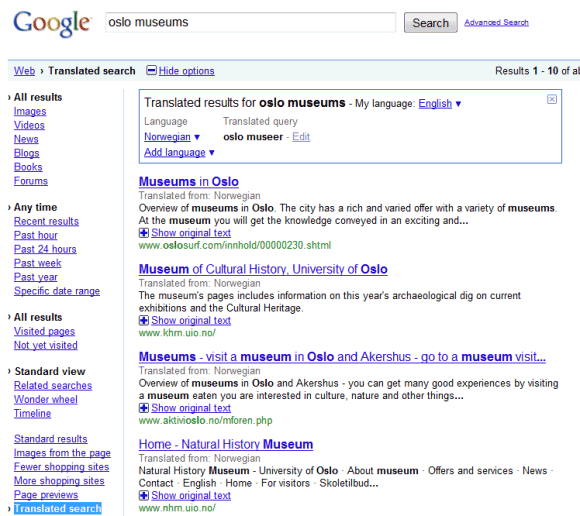
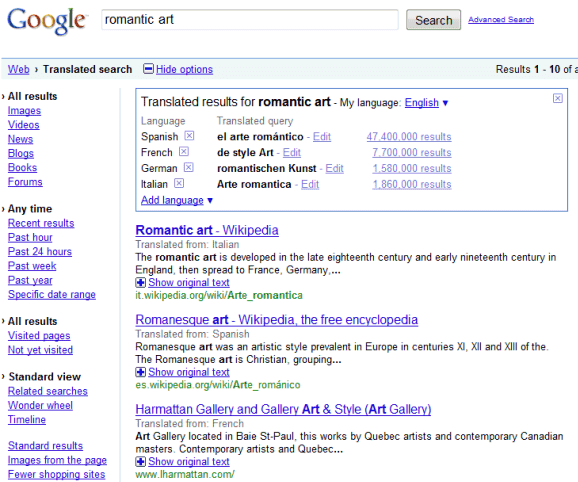
"If you're traveling and want to find hotels, restaurants, activities or reviews written from a local perspective, or if you're just curious to find what's being written about a company, product or topic in another language, give Translated search in the Search Options panel a try," suggests Google.
The feature is now available in the search toolbelt and it's much smarter: Google automatically detects the most appropriate languages for your query. Click on "show options", select "translated search" and Google shows a box that lists some languages, the translations of your query and the top search results for those translated queries.
For example, if you search for [oslo museums], Google shows a list of web pages written in Norwegian. When you search for [romantic art], Google suggests more than one language: Spanish, French, Italian and German.


"If you're traveling and want to find hotels, restaurants, activities or reviews written from a local perspective, or if you're just curious to find what's being written about a company, product or topic in another language, give Translated search in the Search Options panel a try," suggests Google.
December 3, 2009
YouTube Feather
Feather is a new feature from YouTube Labs. The goal is "to serve YouTube video watch pages with the lowest latency possible. It achieves this by severely limiting the features available to the viewer and making use of advanced web techniques for reducing the total amount of bytes downloaded by the browser."

Chrome's dev tools show that the improvements are noticeable: the resources downloaded when you watch a video only have 52 KB, instead of 391 KB.

There are many missing features in the "feather" version: search suggestions, posting comments, viewing all the comments, rating videos, customizing the embedded player. Another issue is that the lite version is not available for all videos.
{ Thanks, Michael. }

Chrome's dev tools show that the improvements are noticeable: the resources downloaded when you watch a video only have 52 KB, instead of 391 KB.

There are many missing features in the "feather" version: search suggestions, posting comments, viewing all the comments, rating videos, customizing the embedded player. Another issue is that the lite version is not available for all videos.
{ Thanks, Michael. }
December 2, 2009
Google's Homepage Goes Back to Basics
Google has been testing a new version of its homepage that hides the navigational elements until you use the mouse. Most people visit Google's homepage to search the Web, so the links to other Google services are distracting. After testing 10 variants of the new homepage, including an interface that removed the buttons, Google decided to keep the search buttons and to use a subtle fade-in effect before displaying the links.
"Internally, a large number of Google employees have been using the new homepage. They have come to really like it — it represents our focus on great search yet helps searchers efficiently access all of Google's products. Like the new supersized search box we launched several months ago, this change is one that is very noticeable at first, and then quickly becomes second nature," explains Google's blog.


I rarely go to Google's homepage to search the Web, since browsers include a search box and I don't have to load a new web page to enter a query. The latest UI changes will make me visit Google's homepage more often: the search box is bigger, the search results are loaded without opening a new page using Ajax and the new clutter-free interface helps you concentrate.
"Internally, a large number of Google employees have been using the new homepage. They have come to really like it — it represents our focus on great search yet helps searchers efficiently access all of Google's products. Like the new supersized search box we launched several months ago, this change is one that is very noticeable at first, and then quickly becomes second nature," explains Google's blog.


I rarely go to Google's homepage to search the Web, since browsers include a search box and I don't have to load a new web page to enter a query. The latest UI changes will make me visit Google's homepage more often: the search box is bigger, the search results are loaded without opening a new page using Ajax and the new clutter-free interface helps you concentrate.
